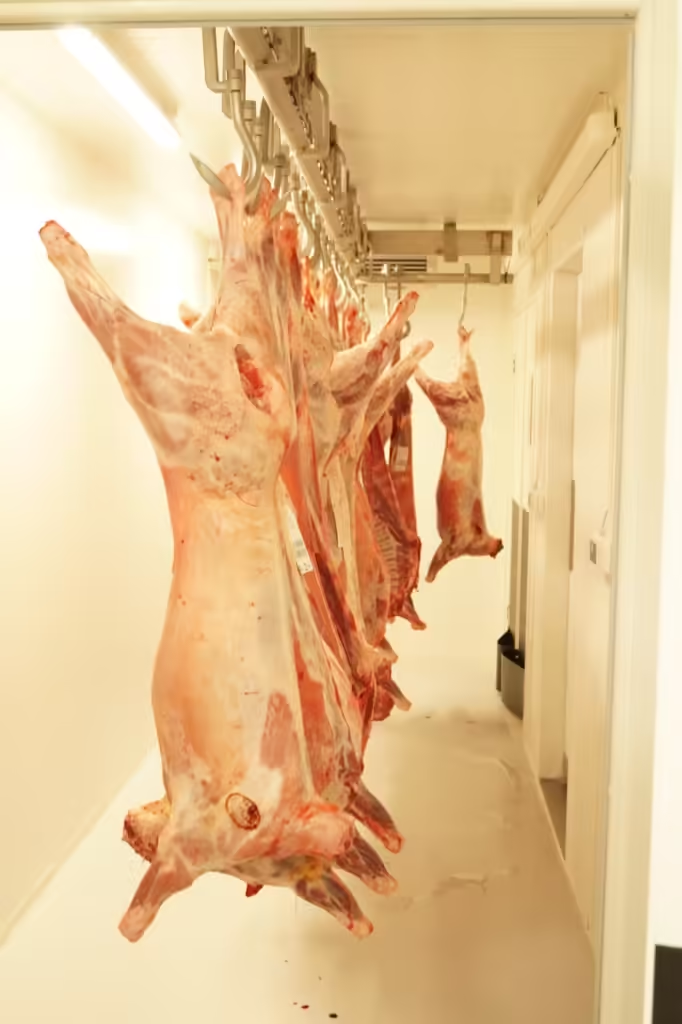Table of Contents
Recently, the pork business has been under pressure, with California setting the precedent with Proposition 12. Pork producers are required by Prop 12 to give sows more humane living circumstances. These modifications, which can cost up to $4,000 per pig in some areas, are meant to ease the stress that pigs experience during childbirth. One of the challenges the pork business has experienced recently is Prop 12, which is partly due to people’s desire to consume something other than pork or, at the very least, to make sure that conditions for pigs living in pig farms improve to a more acceptable degree.
While the farming community has been arguing that a farm bill is needed to support financially strapped pig producers, many who abstain from pork consider these actions as successes.
The truth is that pork is not consumed by billions of people worldwide. Their motivations differ, but issues such as Prop 12 shed light on a few of the reasons why so many houses don’t serve pork. For religious reasons, some people abstain from pork. Some refrain from consuming pork due to its ecological consequences. Others have switched from bacon and pork chops to spaghetti and broccoli because they are offended by the way pigs and people are treated at pig processing facilities. Furthermore, pigs are incredibly dirty on the inside as well.
Here are some of the reasons why so many people have chosen not to eat pork, from the “murderhouse blues” to kosher food.
It’s Forbidden In The Torah
The term “kosher” most frequently connotes kosher salt to people who do not practice Judaism. Although kosher is a label, there are many regulations that go along with it, such as what kinds of meat are acceptable for kosher eaters. The kinds of meat that kosher diners will and won’t eat—pork being the most popular—do, however, remain prominent.
Pork and shellfish are seen as dirty animals. For this reason, pork is off-limits to the 22% of American Jews who follow a kosher diet—along with countless more worldwide. An animal must have cloven hooves and chew its cud to be considered kosher. Despite having cloven hooves, pigs do not chew their food. Sheep and cows satisfy both requirements, which is why kosher homes employ them for dinner. We refer to those creatures as ruminants.
Although the general uncleanliness of a pig’s system has been shown by current science, this dietary restriction dates back to ancient times. For example, scientific studies reveal that the pig’s system had parasites, indicating how savvy the prehistoric kosher eaters were.
Muslims Avoid Pork, Too
Their dietary regulations significantly decreased the risk of infection, and for many people, kosher knowledge still governs the table today.
Pork is one of the things that the Quran refers to as “haram,” or unclean food. Although the Quran’s dietary regulations predate Jewish food rules by the same amount, contemporary science has subsequently validated the reasoning for the halal label, which designates meats suitable for consumption by Muslims worldwide.
It is hardly hyperbole to suggest that Muslims view pigs as walking trash cans because they are teeming with various poisons, bacteria, and even certain worms, such as the trichinae worm. It doesn’t help that pigs even consume their own excrement.
Muslims therefore hold to the belief that “You are what you eat,” which implies that consuming pork results in a person’s character and constitution being identical to that of the pig they eat. This rule only applies in circumstances where there is a risk of famine owing to a shortage of food options.
Seventh Day Adventists (SDA) Agree That There Should Be No Pork
Religious adherents of Seventh-Day Adventism are among those who abstain from eating pork. They follow the dietary restrictions of the Jews by abstaining from eating unclean meats like pig. They go a step further, though, and typically avoid eating any form of meat.
Adventists in Loma Linda, California, have firmly established themselves in the Blue Zone due to these dietary practices. Blue Zones are regions on Earth where a greater proportion of the population survives to reach 100 years of age or older. There are five Blue Zones in the world, but only one in the United States, at Loma Linda, partly because so many Adventists live there and follow a vegetarian, pork-free diet.
But for Adventists, veganism and vegetarianism are nothing new. Since the early days of the church, almost 150 years ago, Adventists have followed Jewish dietary laws and have started eating vegetarianism to resemble the diet that Adam and Eve would have consumed in Eden. One could argue that Eden was the first Blue Zone in history to be free of pork, where the first humans lived.
Most Indians Avoid Pork Frequently
Indians consumed pork up until the sixteenth century. When the Muslim Mughal Empire took control of the nation, that was altered. Pork intake is not strictly forbidden by any of India’s major religions, but the country’s Muslim invaders’ influence still shapes people’s dietary preferences.
According to data from the PEW Research Center, 81% of Indians follow some kind of dietary restrictions when it comes to meat. However, the way this manifests itself varies, therefore some of them aren’t fond of pork or other certain types of meat. Some limit the number of days they consume meat, while the majority of Indians identify as vegetarians. Due to the diversity of religions—Muslims, Christians, Hindus, and Jains, for example—each of which has its own set of dietary regulations, these limitations change.
Although some Indians abstain from eating pork for religious reasons, there is also a widespread belief among Indians that pigs are disease-ridden walking targets. People’s knowledge of the distinctions between scavengers like pigs and ruminant animals like cows gives rise to this idea. Ruminant animals use four stomachs to break down their food over the course of a day. Pigs have a single stomach, and it takes them four hours to process their entire diet. During British control in India, the image of pigs as walking garbage scows became so problematic that it was frequently almost impossible to find cooks who would prepare morning bacon or ham for the British.
Some Would Rather Eat Nothing At All Contains Meat
While certain religious groups, such as Seventh-Day Adventists, adopt a vegetarian or vegan lifestyle primarily due to health concerns, some people abstain from eating meat altogether, including pork. Certain people who identify as “vegan” or “cruelty-free” and who avoid eating pork also think that animals have emotions. Their choice of cuisine is mostly influenced by their refusal to consume any form of animal products. In addition to abstaining from meat consumption, they also avoid purchasing leather goods and, in the worst situations, will not purchase goods that involve dubious labor methods or conditions.
Their warning about preventing pig mistreatment is particularly poignant. According to PETA, every year 170,000 pigs suffer horrendous and brutal deaths while being transported to slaughterhouses, and a further 500,000 pigs sustain excruciatingly painful injuries as a result of road accidents leading to the bacon bridge. When transport trucks crash, they are frequently left to die where they are and are not given any medications for their injuries. For those in this group who do not consume pork, resisting the morning lure of bacon is equivalent to abstaining from this all too common brutality.
Research Has Connected Processed Or Cured Pork To Cancer

Bacon has gained some notoriety in recent years, as anyone who has spent any time on social media will attest to. The cured flesh creates an amore often only experienced by lovers. The nitrates and other compounds that give bacon its crispy, pink delectability contribute to its allure. Put this down to the salts found in nitrates.
However, nitrates have other benefits as well. It has been demonstrated that nitrates induce cancer in mice. A study conducted by Queen’s University Belfast found that mice fed meat containing nitrates saw a 75% increase in intestinal tumor development compared to mice fed a different diet. These kinds of research results have led scientists to label cured meats as carcinogenic and to outright ban nitrates in entire nations. Although humans are not mice, some people may be more susceptible to cancer if they consume as few as four pieces of bacon daily. For this reason, some health-conscious eaters steer clear of pork, or at least avoid cured pig.
Parasites and Pigs Go Together
If given the choice, most individuals would not intentionally consume a trichinella worm. This is due to the fact that, given the correct conditions, these worm larvae burrow into the intestines and eventually make their way to the body’s muscles, where they can cause havoc. The worm carrier may become extremely ill as a result, with symptoms such as headaches, pink eye, fever, debility, and more.
What then are the ideal conditions for this burrowing beast to enter your muscles and intestines? You can get a serious case of trichinosis if you consume pig that has been contaminated. However, there are other parasites that live inside pigs than the trichinella worm. Pigs’ bodies are home to a variety of other parasites and viruses, such as menangle viruses and tapeworms.
Pigs with infections can spread their ailments to humans who come into contact with these little pests.
The ingestion of these pathogenic bacteria, worms, and viruses can cause rheumatism, multiple sclerosis, gall bladder problems, and digestive disorders. Given that these viruses and bacteria can spread from pig to human simply by eating the meat of diseased pigs, it goes without saying that many people are discouraged from eating pork as a result of these tiny dark actors. For many of those who choose not to eat pig, the best course of action is to avoid them altogether because, in many situations, cooking the food to perfection doesn’t even cook out the small critters.
Pork Has the Potential to Inflame the Body
Inflammation is brought on by omega-6 fatty acids. Simply put, compared to its omega-3 content, pork has a higher concentration of omega-6 fatty acids. Pork is therefore among the foods that cause the most inflammation. Furthermore, uncured pork may cause those who already experience inflammation to reconsider indulging in pork chops and other pig cuts, even though it is well known that cured pork increases the inflammatory component. This is due to the fact that red meat—including pork—has a reputation for inducing inflammation.
But practically speaking, what does that mean? Conditions and illnesses including arthritis, heart disease, and even weight gain can be brought on by inflammation. Individuals with these conditions will stay away from items that cause inflammation. For many, this means giving up Easter ham and bacon for healthier options that are easier on the joints, heart, and other systems. Tofu, fish, and beans are better choices for meat-averse gourmets since they provide the same amount of protein as pork while also being more inflammatory- and body-friendly.
Pig Liver Is A Rich Spot For Hepatitis E.
Zoonotic diseases are the kind of thing you might expect to learn about from watching a science fiction film like “Dune,” in which characters get some bizarre illness as a result of traveling to different planets. However, this type of illness actually signifies the spread of disease from domestic or wild animals to people. The illness in question for those who consume pork, especially hog liver, is hepatitis E.
Even though it’s a typical occurrence on most pig farms, it’s frequently undetected until it’s too late which of the pigs in concern contain the disease. The onset of hep E symptoms is frequently the major clue that the illness is present.
If you have had pork within the past few days and you are experiencing symptoms such as low-grade fever, jaundice, vomiting, lethargy, and abdominal pain, you should visit your doctor to determine whether you have contracted hepatitis E.
Hep E is often a transient liver disease that affects most people. However, in those with compromised immune systems, the illness may become persistent. This covers people who are pregnant, have received organ transplants, or are HIV/AIDS positive.
Because of the potentially dangerous nature of the sickness, some people choose to completely avoid consuming hog meat, even though it can be prevented by cooking it properly. It’s also important to remember that not all carriers of the disease are pigs.
It’s also important to remember that not all carriers of the disease are pigs. Additionally, it can be found in the flesh of wild animals like deer.
Pigs Can Have Bacteria That Are Resistant To Drugs
Through contact with the germ on hands, or occasionally by going from nose to hand and then from person to person through the hands, Staphylococcus aureus spreads from one person to another. But pigs are home to a particular type of bacteria. It turns out that pigs can spread bacteria just as effectively as your hands can.
Regretfully, some of the bacteria that spread from pig to human are classified as superbugs because they have a unique resistance to antibiotics, which they can use on either a pig or a human.
CC398 is one of the bug’s strains. Cambridge University claims that it has been traveling through Europe on the backs of hitchhikers for many years. It is somewhat slippery in the only manner that a microbe can be, but being the cunning thing that it is, it has managed to cross the pond and reach the United States and beyond. Because of how quickly the superbug can move from animal to human, it has alarmed the scientific and medical communities.
However, the tiny pig next door isn’t the only one bothered by that insect. Additionally circulating is the bacteria Clostridium difficile, which induces inflammation and upsets the digestive system. These difficulties pose a serious problem for medical professionals everywhere.
Every year, hundreds of thousands of individuals pass away from the bugs.
Pork Production Facilities Are Bad For Workers And Pigs

A pig farm is as distant from “Charlotte’s Web” as possible, as socially minded foodies know. Consequently, they abstain from consuming pork since pig farms are everything but a picnic, beginning almost at the time of a pig’s birth. As things naturally unfold, it can take up to three months to wean a young pig from its mother.
The process takes three or four weeks in a factory, after which the piglets are placed in a cage with ear and tail slashes to facilitate identification and avoid tail biting in such close quarters.
For their mothers, life isn’t all that much better. Every year, over six million pigs are designated for breeding. These pigs were far superior to the most advanced factory equipment available during the Industrial Revolution at the beginning of the century. They give birth to piglets after piglets, with a brief respite of four months during which they are pregnant and nursing before the cycle begins again.
However, not all of the victims are pigs. To put it mildly, pig farm laborers lead erratic lives. It’s an unsettling noise. Because of the dust and other particles in the air, respiratory ailments are becoming more and more common. Pig farms are also a popular hangout for salmonella. Therefore, it should come as no surprise that pig farmers can experience issues with depression, family issues, and occasionally even suicide.
It Is Horrible For The Climate

Pig farming may not be the first thing that springs to mind when you think about climate change, but it should. According to Biological Diversity, each person’s annual intake of bacon results in an environmental cost of around 1,050 pounds of carbon dioxide equivalents.
You could reasonably assume that poundage must equal a very large amount of bacon. It’s not. Each person receives fewer than 52 slices annually. You may be wondering at this point how something like this could continue. In conclusion, the pork business is incredibly powerful in the global market, commanding a trillion dollars. According to Food Print, approximately 30 swine processing facilities account for 92% of all pork produced in the United States.
However, everything is not lost. According to certain accounts, the pig industry has been significantly impacted by the growing veganism movement. According to Live Kindly, the environmental effects of eating meat, especially pork, have led nearly 50% of young adults to avoid it. The meat business will lose $20 billion by 2020 as a result of the 600% growth in interest in veganism in recent years. One thing is certain: People have started voting with their wallets, and the pork business is repeatedly being voted off the table, even though the numbers on both sides have somewhat evened out since then.
read also: The Secret to Ground Beef I Discovered After 25 Years of Cooking
Billions Of People Around The World Don’t Eat Pork. This Is Why (msn.com)


1 thought on “The world’s population, in billions, abstains from eating pork. That’s the reason”